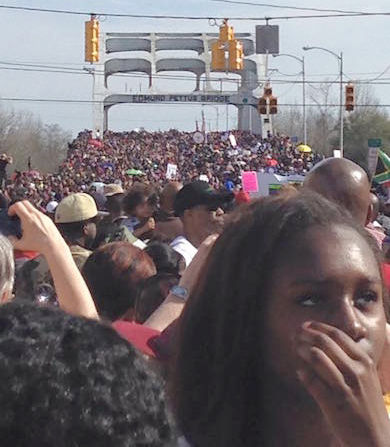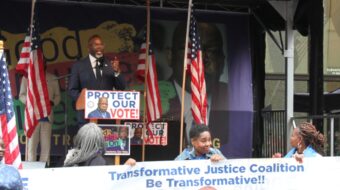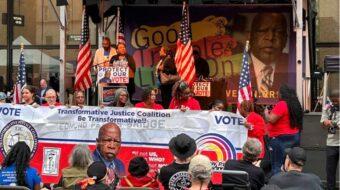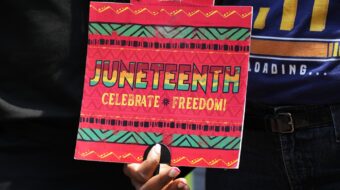
In March 1965, I was a month shy of my fourth birthday. For me, the only momentous occasion of that time was a stay in the hospital for a tonsillectomy. I can still remember the ice cream they let me eat sliding down my rough throat. For that little working-class white girl, Alabama was a long way from the northwest side of Chicago-geographically, culturally, politically. So why, 50 years later, did I take the pilgrimage to Selma? Why wend my way on a sun-baked Sunday, in the company of thousands of other Americans, to cross a bridge over the Alabama River? I guess it’s about story. Of all the stories Americans tell ourselves of who we are and what our national experiment is about, the story of the Civil Rights Movement, its sung and unsung heroes, is the most resonant for me.
As a sensitive child growing up in personally and politically chaotic settings, non-violence intuitively made sense before I knew there was a philosophy. The story of Selma fifty years ago, the moral and physical courage it took to cross that bridge into a sea of baton-wielding police officers, and walk for four days in an assertion of basic democratic rights is the American story I am most drawn to, the American story I want to be associated with, that tells of the American heroes I most want to honor. The story of Selma 1965 represents the worst and the best of America: our home-grown terrorism, police brutality, and abuses of power, AND the immense courage, planning, discipline, righteous anger, and persistence that can confront evil and bring about change.
We need all of the latter today-to counter the continued threats to voting that come from without, and from within our sometimes apathetic selves; to counter Big Money and hopelessness over its influence; to fight against growing income inequality and the inequities of education, work, and quality of life that accompany it.
It took no courage to make my trip across the bridge; this time around, the Alabama State troopers-black and white-were there to guide traffic and mostly be helpful-or sometimes just watch the scene. Some chatted with marchers when foot traffic was stalled. While standing in the street outside Brown Memorial Chapel as dignitaries like Eric Holder came out to their cars, several people and I were asked by a trooper to move away from his vehicle so he could get out: “I wouldn’t want anyone to get hurt by a tire rolling over your foot!” While in 1965, marchers, abusive police, and by-standers were photographed by journalists, in 2015, we all could be participants and documenters of the action. Everywhere I looked, cellphones were up in the air at the end of black, white, and brown arms. Close to the bridge, jumbo screens allowed barely-moving marchers to see and hear Dr. King deliver his speech in Montgomery on March 25, 1965 and speeches by participants in anniversary marches past. I had the odd experience of walking about five people away from Jesse Jackson, while listening to a ten years younger version of him on the screen say, “American democracy wasn’t born in 1776; American democracy was born in Selma in 1965.”
But, this march wasn’t just about what happened 50 years ago. It was about what is happening now. I walked with Unitarian Universalists from a conference where we remembered the Rev. James Reeb and Viola Liuzzo-the two Unitarians who came to Alabama in March 1965 to support civil rights workers and were, along with Alabama resident Jimmie Lee Jackson, killed for their participation. But, we also attended sessions on the Black Lives Matters movement, environmental racism, and other social justice work needed today. Other marchers wore t-shirts with photos of family members who had been killed by police, calling for reforms of the justice system. As John Legend and Common point out in their award-winning song “Glory,” “Selma is now.”
It is not only Selma. In Birmingham, Kelly Ingram Park is the site of 1963 civil rights protests and “Bull” Connor’s fire hose and attack dog-wielding police. Today, it is transformed into a Civil Rights Movement memorial. Carved into the stone wall at the entrance are the words: “Place of Revolution and Reconciliation.” I walked between two metal walls, out of which jumped large sculptures of dogs, straining at their leashes, sharp teeth bared. Glancing through jail-like bars, I saw two children, standing in a doorway over the inscription, “I Ain’t Afraid of Your Jail,” commemorating the 1963 Children’s Campaign. At the corner of the park, kitty-corner from the Sixteenth Street Baptist Church, are statues of the four girls killed in the 1963 bombing of the church.
On my 2015 visit, it was peaceful in the park. Two older black men, park employees, pulled plastic bags out of the garbage cans, tied them up, and tossed them into a container on wheels. One employed a metal stick to pick up some trash on the ground, but for the most part, this space is clean and well-cared for. Thought went into the design of the sculptures to evoke emotion: respect for those who put their bodies on the line for a just cause, revulsion against a system that would sic dogs trained in violence onto non-violent protestors. This place of state violence and hate and resistance and moral courage, this place of power abused and power claimed, is a memorial. We remember what happened in the past-as we ought. But, what good is remembering how a young Girl Scout, who loved reading and the piano and aspired to become a teacher should not have had her life blown away, that her parents and family and church and community should not have had a hole blown through their hearts, if we let other young girls today grow up under-educated, abused, discriminated against?
What good is it to remember Bull Connor’s evils as a leader of police if we do not also work to change the culture of policing that works against people of color-and others-today? What good is remembering morally courageous leaders of the past: Fred Shuttlesworth, Martin Luther King, Diane Nash, if today we sit complacently, or hopelessly, or tiredly by while morally bankrupt leaders sell themselves to wealthy oligarchs and hurt the poor, people of color, and workers? The American story told in the remembering of civil rights events fifty years past is one that can help us as we work to make our present a more just and fair one for all Americans.
Cathy Colton teaches English at the College of Lake County and blogs on “Mad Men.”
Photo: In the sea of humanity, we slowly make our way to the Edmund Pettus Bridge, while others were walking off. It was an amazing, moving afternoon, reaching back to an incredibly significant moment, March 8, 2015. (Courtesy of Cathy Colton)










